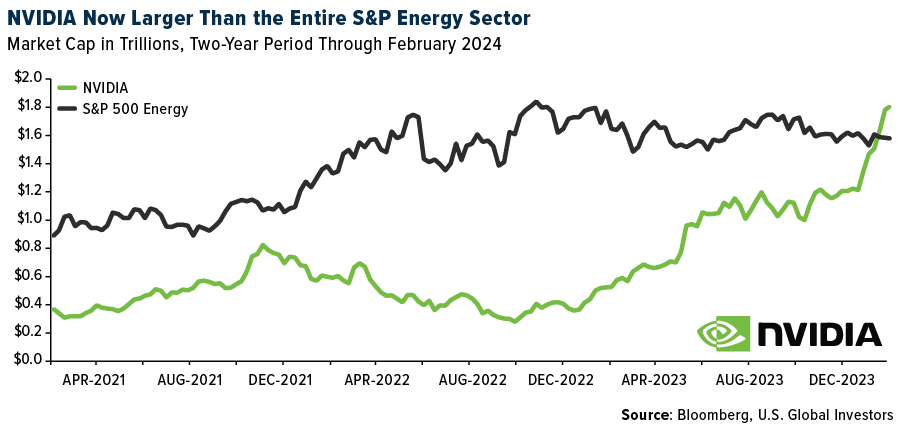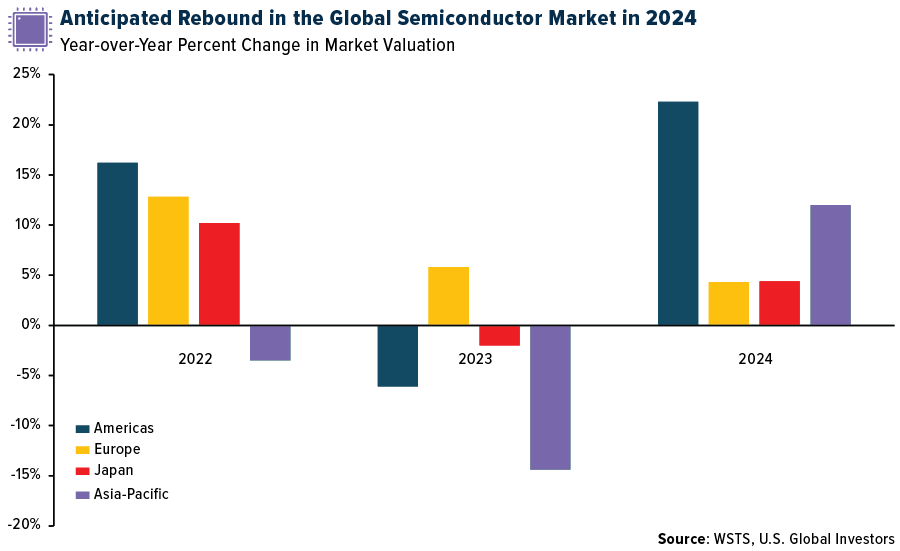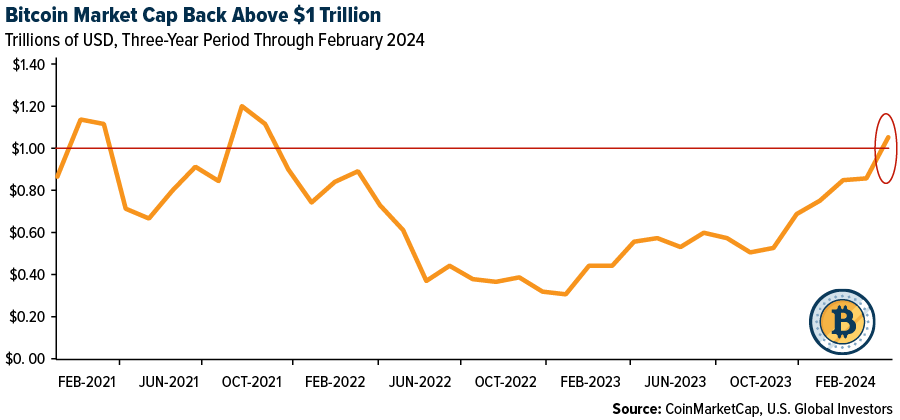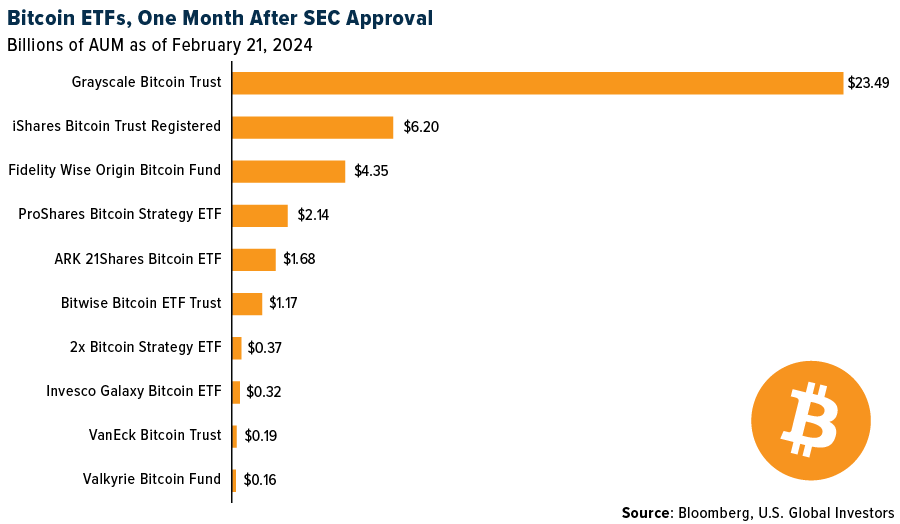

AI Revolution Sparks NVIDIA’s Historic Market Cap Achievement
NVIDIA reported financial results for the fourth quarter and full-year 2023 last week, and I’m still picking my jaw off the floor.
NVIDIA reported financial results for the fourth quarter and full-year 2023 last week, and I’m still picking my jaw off the floor. The chipmaker handily beat Wall Street expectations, with annual profits increasing a staggering 769% on mounting enthusiasm surrounding artificial intelligence (AI).
Already the world’s fourth-largest company by market capitalization ahead of Amazon, Alphabet and Meta, NVIDIA set another new record on Thursday when its market cap surged $277 billion, marking the biggest one-day increase for a single name in history, according to Bloomberg. It’s now valued at just under $2 trillion, which I was surprised to learn is greater than the combined market caps of all S&P 500 energy stocks.

Sparked in November 2022 with the launch of ChatGPT, the AI boom has supercharged demand for the kinds of advanced chips that NVIDIA produces, making the company a go-to “pick and shovel” play.
It’s a role the company should be accustomed to. For years, NVIDIA was known primarily as a gaming stock, having invented the graphics processing unit, or GPU, in 1999. The GPU introduced sophisticated, three-dimensional graphics to the home video game market, but today, that same technology is helping to power not just AI but digitization as a whole.
A $7 Trillion Plan to Secure Chip Supply
Jensen Huang, NVIDIA’s cofounder and longtime CEO, believes we’re witnessing the start of a whole new industry with AI, and particularly generative AI. Indeed, an increasing number of tech firms are rolling out their own generative AI platforms to remain competitive, with varying degrees of success. (Last week, Google paused its Gemini AI image generator in response to complaints that it was too woke.)
With everyone tripping over their shoelaces to catch the AI train, demand for semiconductors and chips could very well outpace supply. The 2020-2023 global chip shortage—fueled primarily by pandemic-related supply chain issues—has largely evaporated, but it’s easy to imagine never-ending cycles of undersupply going forward if investment doesn’t keep pace with the technology.
Fortunately, the outlook for this year points to what the World Semiconductor Trade Statistics (WSTS) calls a “vigorous upswing,” with expectations of a 13% increase over 2023 in total industry market valuation. All major markets are forecast to expand this year, with the Americas growing the most at 22%.

Full disclosure, the WSTS made this forecast back in November 2023, and since then, I believe conditions (and investor enthusiasm) have only improved and will continue to improve, starting with a more favorable monetary environment. In addition, earlier this month, the Biden administration announced a $5 billion investment in semiconductor R&D as part of the CHIPS Act, signed in August 2022.
If $5 billion is a lot, how does $7 trillion sound? That’s the dollar amount Sam Altman seems to have settled on to significantly increase global chip production and boost AI. The ChatGPT chief executive has been on a fundraising tour as of late, trying to raise capital for a “wildly ambitious tech initiative,” according to the Wall Street Journal. Although it’s unclear how the unfathomable sum of $7 trillion would be deployed exactly, the United Arab Emirates (UAE) has reportedly signed on to Altman’s idea, announcing that it will spend heavily to become a global hub and testing ground for AI technology and regulation.
How Bitcoin ETFs Have Fared One Month Later
A discussion on the great digital transformation would be incomplete without mentioning Bitcoin (BTC). One month after the Securities and Exchange Commission (SEC) simultaneously approved a number of spot Bitcoin ETFs, the world’s number one digital asset is back above a $1 trillion market cap for the first time since December 2021.

According to one source, nine Bitcoin ETFs collectively accumulated over 250,000 BTC in less than a quarter, the equivalent of $12.8 billion based on today’s prices. And that’s not counting other major, institutional investors like Tether and MicroStrategy, the enterprise software firm that’s recently rebranded as the world’s first Bitcoin development company.
Below, you can see where the ETFs stand in terms of AUM. In the first month, investors poured an estimated $125 million into these products every day, according to CoinDesk. Grayscale leads the others with over $23 billion invested, but it’s also seen the heaviest outflows since the firm got the go-ahead to convert its Bitcoin trust into an ETF a month ago.

Just as AI has sparked insatiable demand for advanced chips, U.S.-based Bitcoin ETFs have helped goose investment in the underlying asset.
And like chips, BTC could at some point face a serious shortage. According to Michael Saylor, cofounder and executive chairman of MicroStrategy, demand for Bitcoin ETFs is 10 times the supply. I don’t know where this figure comes from, but I have no reason to question it.
Also affecting supply is the upcoming Bitcoin halving. The next halving is expected to take place in April, after which the reward for mining Bitcoin will fall from 6.25 BTC to 3.125 BTC. Currently, about 900 BTC are mined per day; this will drop to around 450. That means there will be even fewer BTC on the market for investors to bid on.
Plan accordingly.
Past performance does not guarantee future results. All opinions expressed and data provided are subject to change without notice. Some of these opinions may not be appropriate to every investor. By clicking the link(s) above, you will be directed to a third-party website(s). U.S. Global Investors does not endorse all information supplied by this/these website(s) and is not responsible for its/their content.
Standard and Poor’s 500 Energy Index is a capitalization-weighted index. The index was developed with a base level of 10 for the 1941-43 base period.
None of U.S. Global Investors Funds held any of the securities mentioned in this article as of 12/31/2023.






























